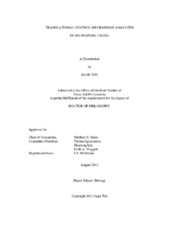| dc.description.abstract | The Neurospora crassa arg-2 gene encodes the small subunit of carbamoyl phosphate synthetase, the first enzyme in fungal arginine (Arg) biosynthesis. The arginine attenuator peptide (AAP), specified by an upstream open reading frame (uORF), stalls ribosomes at its termination codon in response Arg to control the translation of arg-2. In project 1, the effect of AAP and Arg on ribosome peptidyl transferase center (PTC) activity was analyzed in N. crassa and wheat germ cell-free translation extracts using the transfer of nascent AAP to puromycin as an assay. The results show that inhibition of PTC activity by the AAP and Arg is the basis for the AAP’s function. The mode of PTC inhibition appears unusual because neither a specific amino acid nor a specific nascent peptide chain length was required for AAP to function.
In eukaryotic translation initiation, the stringency of start codon selection impacts initiation efficiencies at AUG codons in different contexts and at near-cognate codons (NCCs) that differ from AUG by a single nucleotide. In project 2, a codon-optimized firefly luciferase reporter was used to examine the stringency of start codon selection in N. crassa. In vivo and in vitro results indicated that the hierarchy of initiation in N. crassa is similar to that in human cells. The preferred context was more important for efficient initiation from NCCs than from AUG.
In project 3, the use of NCCs was also specifically examined for the N. crassa cpc-1 gene. cpc-1 and Saccharomyces cerevisiae GCN4 are homologs specifying a transcription activator, which drives the primary transcriptional response to amino acid starvation. In vitro studies showed that uORF1 and uORF2 in cpc-1 are functionally analogous to uORF1 and uORF4 in GCN4. uORF1 promotes reinitiation at downstream start codons. uORF2 inhibits translation from the main cpc-1 start codon. Four NCCs in the CPC1 reading frame and upstream of uORF2 can also be used for translation initiation.
In summary, we explored uORF-mediated translational regulation and the use of NCCs as initiation codons. Taken together, these studies establish N. crassa as a model system to examine mechanisms contributing to translational control including initiation and termination. | en |


